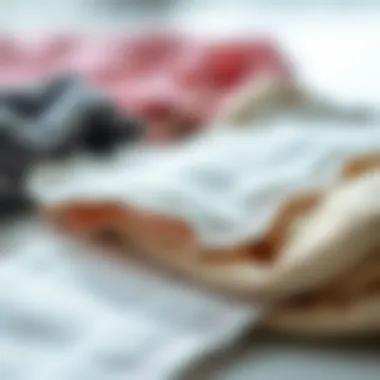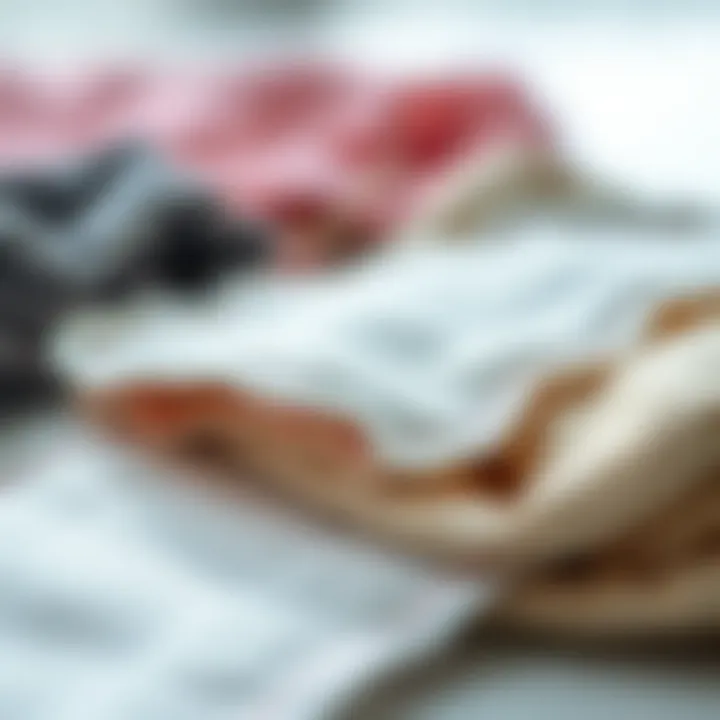Reusable Pads: A Sustainable Choice for Heavy Flow


Intro
The conversation about menstrual hygiene products is gaining momentum, and for good reason. With many people seeking alternative solutions to traditional disposable options, reusable pads have begun to capture attention, especially for those who experience heavy menstrual flow. The appeal lies not only in the potential comfort of these products but also in their sustainability. As the world moves toward eco-conscious decisions, the efficacy of reusable pads offers an intriguing avenue to explore.
In this article, we'll uncover a myriad of aspects related to reusable pads, from design to material effectiveness, and how they stack up against their disposable counterparts. By doing so, we aim to empower readers with detailed insights, enabling informed choices in their menstrual health management.
Understanding Reusable Pads
Reusable pads are crafted from absorbent materials, designed to be washed and reused instead of thrown away. This characteristic contributes to a reduced environmental footprint, resonating with the growing interest in sustainable living. But, beyond eco-friendliness, do these pads perform well under the heavy flow?
Key Components
- Material Choices: Common materials for reusable pads include cotton, bamboo, and microfiber. These fabrics offer different levels of absorbency and comfort, making it essential to select the right one for your needs.
- Design Elements: The design of reusable pads can vary significantly, from winged styles for added security to varied thicknesses tailored for different flow levels.
"Choosing the right reusable pad is like finding a good pair of shoes — comfort and fit are paramount."
Effectiveness for Heavy Flow
When discussing heavy flow, it’s crucial to consider the effectiveness of reusable pads. Many products on the market are crafted specifically to manage heavier menstrual flow. Here are some points to consider:
- Absorbency Levels: Some pads are designed with multiple layers to increase absorbency without sacrificing comfort. This feature can provide peace of mind over potential leaks.
- Wicking Properties: The ability of a pad to wick moisture away from the skin affects wearability. A well-designed reusable pad will not only absorb but also keep you feeling dry.
- Durability: Frequent washing can wear out materials, but some brands emphasize long-lasting constructions that can hold up for years.
Care Instructions
To maintain the efficacy of reusable pads, proper care is essential. Here are some common practices:
- Pre-wash: Rinsing pads in cold water immediately after use can limit staining and odor.
- Machine Wash: Using a gentle cycle with mild detergent helps maintain fabric integrity.
- Air Dry: While some pads can handle tumble drying, hanging them to dry is often the safest method to prolong life and effectiveness.
Reusable Pads vs. Disposable Options
The choice between reusable and disposable pads often comes down to personal preference, but there are plenty of differences worth considering:
- Cost-Effectiveness: Over time, reusable pads can be more economical since they last for years, while disposable options incur ongoing costs.
- Environmental Impact: Disposable pads contribute significantly to landfill waste, whereas reusable pads offer a more sustainable alternative.
- Comfort: Many users report that reusable pads are softer against the skin compared to some disposables, which can often use synthetic materials.
Preamble to Reusable Pads
Understanding reusable pads is vital in today’s discourse on menstrual health and hygiene. This article explores their importance, especially for individuals experiencing heavy menstrual flow. Given the increasing scrutiny on traditional menstrual products, reusable pads present an alternative steeped in environmental consciousness and personal comfort. The rise in discussions about sustainability makes this subject both timely and crucial.
Definition and Purpose
Reusable pads are absorbent cloth pads designed for menstruation, meant to be washed and reused multiple times. Unlike traditional disposable pads, these products are made from textiles such as cotton, bamboo, or microfiber. Their primary purpose is to provide a sustainable, eco-friendly option for individuals aiming to manage their menstrual cycles effectively.
Here are some key purposes served by reusable pads:
- Cost-Effective: While the initial investment might seem high, over time, reusable pads can significantly reduce menstrual product expenses.
- Comfort: Many users report that cloth pads feel more comfortable against the skin compared to synthetic materials found in disposables.
- Environmental Considerations: Using reusable pads cuts down on waste, contributing to less plastic in landfills and the overall reduction of single-use products impacting the planet.
By focusing on these objectives, reusable pads offer practical solutions while also encouraging users to make environmentally conscious choices.
Historical Context of Menstrual Products
To better understand the relevance of reusable pads, it’s essential to look at the historical context of menstrual products. For centuries, individuals dealt with menstruation in various ways. Ancient cultures used natural materials such as wool, grass, and cotton as absorbents. It was not until the 19th century that commercial pads began to emerge, with products such as the first disposable pad being made available during World War I.
This historical evolution reflects societal attitudes towards menstruation. As communities became more modernized, convenience overshadowed traditional practices, leading to the widespread adoption of disposable options by the 20th century. Today, however, there’s a noticeable shift back towards reusable options as awareness of environmental issues increases.
Thus, understanding the background of menstrual products sheds light on how reusable pads fit into contemporary discussions on health, sustainability, and user choice. This context serves to frame the effectiveness and relevance of reusable pads in the menstrual product landscape.
Understanding Heavy Flow
Understanding heavy menstrual flow is imperative to correctly address the needs of those who experience it. This section sheds light on the specific aspects that define heavy flow, its potential impacts on daily life, and the advantages of selecting the right menstrual products, such as reusable pads.
Medical Insights into Heavy Menstrual Bleeding
Heavy menstrual bleeding, medically termed as menorrhagia, can be a challenging condition for many. It is typically characterized by excessively heavy or prolonged menstrual periods. This may seem trivial to some, but it fulfills a significant role in personal health. Research indicates that nearly 30% of menstruating individuals encounter some variation of heavy bleeding at various points in their lives. The causes can vary, ranging from hormonal imbalances to fibroids, and other underlying health issues.
Understanding the medical basis behind heavy menstrual bleeding aids in reducing stigma around it. Awareness about its effects — like fatigue, anxiety, or mood swings — helps individuals express their needs better, including seeking effective products. It’s essential to realize that heavy flow isn’t just an inconvenience; for many, it can be debilitating.
A few points to consider include:


- Cycle Regularity: Those with heavy flow may find their cycles less predictable, which adds stress to everyday life.
- Impact on Activities: Managing heavy bleeding can deter individuals from pursuing activities, particularly sports or community engagements, for fear of leaks.
- Health Risks: Long-term effects of untreated heavy bleeding can lead to iron deficiency anemia, requiring medical intervention.
Thus, recognizing the impact of heavier cycles not only improves personal management but also guides better product choices.
Common Misconceptions
This section aims to debunk several myths regarding heavy menstrual flow and the use of reusable pads, which could help in alleviating concern and hesitation. Many misconceptions often stem from misinformation, leading to unnecessary panic or choices that do not suit individual needs.
- Misconception: Reusable pads are not effective for heavy flow.
Fact: High-quality reusable pads, designed with multiple absorbent layers and leak-proof backing, can effectively manage heavy flow. They can hold significant volumes of blood while keeping the individual comfortable. - Misconception: They are too complicated to use or clean.
Fact: While initial use may require a learning curve, many users quickly adapt to washing and maintaining their reusable pads. The care process often becomes a simple routine over time. - Misconception: Using reusable pads means a constant worry about leakage.
Fact: Proper sizing and absorbency selection vastly minimize leakage issues. Many brands now offer trial kits to find the perfect fit, easing concerns. - Misconception: They are less hygienic than disposables.
Fact: When cleaned properly, reusable pads can be more hygienic than disposables, which often contain chemicals and fragrances that can irritate the skin.
These common misconceptions hinder many people from exploring alternatives that could enhance their menstrual experience. By sharing factual information, it's possible to shift attitudes and encourage more informed choices regarding menstrual health products.
Advantages of Reusable Pads
The conversation surrounding menstrual products has taken a notable shift, especially when discussing reusable pads. Originally designed for convenience, these pads now showcase a multitude of significant benefits, particularly for those dealing with heavy menstrual flow. Understanding the advantages of reusable pads goes beyond mere preference; it influences health choices, environmental sustainability, and even our pockets. This section unpacks the vital elements contributing to the rising popularity of reusable pads and highlights why they are becoming an undeniable option for many.
Environmental Benefits
Choosing reusable pads contributes to the well-being of our planet. With disposable products, the environmental toll is staggering. Those soft cotton pads, wrapped in plastic, often end up in landfills for hundreds of years. Reusable pads reduce waste considerably; each pad can be washed and reused for years.
"The average menstruator uses around 16,000 pads or tampons in their lifetime. That’s an astronomical figure when you think about how many of these items wind up in landfills."
By making the switch to reusable options, not only does one diminish personal waste, but also contributes to a larger movement aiming for sustainable menstrual health practices. Cotton or bamboo fabrics, commonly used for these pads, are biodegradable and much healthier for the soil compared to synthetic materials found in many disposable pads.
Financial Considerations
Let’s talk about the bottom line. Initially, the switch to reusable pads may seem like a hefty investment; however, when you break down the numbers, it quickly becomes clear that it’s a smart economic decision.
- A full set of high-quality reusable pads can cost anywhere from $100 to $200.
- In contrast, the average person spends about $300 a year on disposable menstrual products.
Over the course of a lifetime, these savings add up. Imagine being able to redirect that money towards other essentials or even luxuries rather than continual purchases of disposables. Beyond just the purchasing aspect, reusable pads also last much longer and often offer better durability than traditional pads.
Health and Comfort Aspects
Reusable pads aren’t just a win for the Earth and your wallet; they can also be a boon for your health and comfort. Many people find that reusable pads reduce skin irritations common with disposable options. Since they’re typically made from natural fibers, there’s less risk of rashes or allergic reactions that synthetic materials might cause.
Additionally, the softness and breathability of fabrics like cotton create a comfortable experience, particularly for those with heavy flow. Comfort isn’t just about how they feel against the skin; it’s also about confidence. Knowing that the product is effective and reliable allows for a seamless and worry-free experience during menstruation.
With these advantages, reusable pads stand as an effective, sustainable, and economical option for menstrual health. Far beyond simple convenience, they offer tangible benefits that resonate on personal, financial, and environmental levels. As we continue exploring the aspects of reusable pads, an informed decision can lead one to a path of better health and sustainability.
Design Features for Optimal Use
When it comes to reusable pads, their design is essential for ensuring a comfortable and effective experience, especially for those dealing with heavy menstrual flow. A thoughtfully conceived design not only enhances functionality but also caters to the diverse needs of users. From materials to size and aesthetics, each aspect plays a crucial role in the overall usability of these pads.
Material Choices
The choice of material can make all the difference when selecting reusable pads. Many users gravitate towards cotton as a fundamental fabric because it's soft against the skin and highly absorbent. Moreover, organic cotton is becoming a sought-after option, as it’s produced without harmful chemicals, making it gentler for both the user and the environment.
Another material to consider is bamboo fiber, which is naturally antibacterial and has moisture-wicking properties. This can prove beneficial for those experiencing heavy flow since it helps to keep the area dry and can reduce odors. Some brands even combine materials, like cotton on the top layer for comfort and a waterproof layer underneath to prevent leaks.
Choosing the right material not only impacts comfort but also influences absorbency and longevity of the pads, so it’s wise to take material choices seriously.
Size and Absorbency Options
The importance of size and absorbency can't be overstated, especially for those burdened with heavy menstrual flow. Reusable pads come in various lengths, widths, and absorbency levels, which cater to individual preferences and requirements.
If you're dealing with heavier days, opting for longer pads can create a sense of security. You might find some brands offering pads that extend up to 14 inches, providing coverage that eases concerns about leaks. Conversely, lighter days may call for shorter, more discreet options.
Absorbency levels are equally crucial. It’s generally advisable to choose pads marked as ultra-absorbent for days with heavier bleeding. Some manufacturers even categorize absorbency as light, moderate, heavy, or overnight, which helps users select the most suitable option without second-guessing.
Patterns and Styles
While functionality is a top priority, the visual aspect of reusable pads shouldn't be dismissed either. The market today has exploded with an array of patterns and colors that make personal preference a fun consideration. Whether one prefers bold designs that express personality or subtle hues that blend in, there’s something for everyone.
Not just for aesthetic appeal, patterns can also be a reflection of the brand’s commitment to breaking stigmas surrounding menstruation. This kind of representation can enhance user satisfaction and break away from the age-old notion that menstrual products should be bland and forgettable.
Comparative Analysis with Disposable Pads


In the realm of menstrual products, the discussion of reusable pads versus disposable options carries considerable weight. This section aims to illuminate the differences that sway many individuals towards one or the other, particularly for those encountering heavy flow. Understanding these distinctions can greatly influence informed decisions related to both personal comfort and broader ecological impacts.
Cost-Efficiency Over Time
When it comes to managing finances, many people first consider the initial purchase price of menstrual products. Reusable pads often stand out in the long run. Though an upfront investment may seem steep—ranging from $20 to $40 for a set—this cost is a proverbial drop in the bucket compared to the ongoing expense of disposable pads. Consumers typically spend between $7 and $15 each month on disposables, adding up to over $100 annually. In contrast, reusable pads can last for years with proper care, leading to considerable savings.
- Initial Cost: Yes, reusable pads have a higher initial cost.
- Long-Term Savings: After the first few months, the savings becomes glaringly apparent.
- Durability: Many reusable options are crafted from high-quality materials that endure through multiple washes, ensuring you get your money's worth.
Given these figures, the long-term perspective indicates that investing in reusable pads can make a significant dent in ongoing menstrual product expenses.
Environmental Impact Assessment
Treading toward sustainability has become increasingly relevant in today’s society. Disposable pads and tampons contribute substantially to landfill waste, with billions of products tossed out every year. Environmental consciousness nudges many to reconsider their choices. Resuable pads, made from biodegradable materials, diminish this impact significantly. While they still require resources for production, their long lifespan means fewer pads will ultimately land in landfills.
- Waste Production: Disposable products generally lead to mountains of waste, while reusable pads typically yield very little.
- Material Impact: Biodegradable materials used in many reusable pads help lessen the overall ecological footprint.
- Waste Breakdown: Even in proper disposal, reusable pads present a lower risk to the environment.
For eco-conscious consumers, this environmental aspect can't be ignored. The shift to reusable pads aligns with a commitment to reduce waste and promote sustainable practices.
User Experience Comparison
Comfort and usability often dictate the choice of menstrual products. Many individuals find that reusable pads offer enhanced comfort as compared to their disposable counterparts. Modern reusable pads incorporate soft fabrics that allow for breathability, minimizing irritation. People with heavy flow also benefit from a customizable experience; they can select different sizes and absorbencies based on their unique flow patterns.
Here’s what users frequently cite:
- Comfort: Many appreciate the softness of fabric against the skin.
- Customization: Select options tailored for a heavier flow day.
- Reduced Odor: Some reports suggest reusable pads help limit odors often associated with disposables.
Yet, the transition to reusable can result in a learning curve. Proper care and washing become essential aspects of maintaining these products. When worn during heavy flow days, a diligent user may find they need to change pads more frequently—a subtle adjustment in routine associations.
As a whole, addressing these comparisons aids the reader in evaluating their personal priorities in the context of menstrual hygiene products. Those navigating heavy bleeding may find in reusable pads an adaptable option that not only caters to comfort and sustainability but also begins to save them quite a pretty penny in the grand scheme.
Care Instructions for Reusable Pads
The maintenance of reusable pads is just as crucial as their initial selection. Proper care instructions not only ensure longevity but also enhance hygiene and comfort, particularly for those managing heavy flows. Understanding how to effectively wash and store these pads is vital for safeguarding their effectiveness, thus allowing users to fully benefit from this eco-friendly option.
Washing Guidelines
Cleaning reusable pads is not an arduous task, but it does require some attention to detail. Here are the essential steps to keep in mind:
- Pre-Rinse: Start with a quick rinse using cold water right after use. This helps to remove any residual blood and prevents staining.
- Washing:
- Detergents: Opt for fragrance-free and environmentally-friendly detergents. Conventional detergents can contain harsh chemicals that may irritate sensitive skin.
- Drying:
- Machine Wash: Toss them in the washing machine on a gentle cycle with similar fabrics. Using a mesh laundry bag can be advantageous to keep pads from tangling with other laundry.
- Hand Wash: If you prefer this method, soak them in cold water for about 30 minutes, then gently scrub with a mild detergent.
- Air Dry: This is the best method to maintain the integrity of the pad, as high heat can break down the materials over time. Just hang them in a well-ventilated area.
- Tumble Dry: If necessary, use the lowest heat setting, but air drying is preferable.
Following these guidelines not only keeps the pads in good shape but also minimizes the risk of bacterial growth, something that can lead to unpleasant odors or infections.
Storage Recommendations
Proper storage is equally important as washing. Taking a few minutes to organize your reusable pads can make the entire menstrual experience more efficient and pleasant:
- Cool and Dry Place: After washing and drying, store your pads in a cool, dry spot. Humidity can encourage mold or mildew growth, which is counterproductive to the health benefits.
- Storage Bags: Consider using a dedicated pouch or container. A breathable cotton bag allows for air circulation while keeping them safe from dust and dirt. Avoid plastic containers, as they trap moisture.
- Samplin’ Organization: Group your pads based on absorbency. For instance, heavier flow pads can be kept together, while light day pads can be in another bag. This organization saves time during your period.
Remember, handling these items with care ensures they remain effective and pleasant to use. Simply treating them well amplifies their benefits while decreasing the environmental footprint.
By adopting proper care practices, individuals can optimize the performance of their reusable pads, making the transition to more sustainable menstruation methods smoother and more effective.
Addressing Common Concerns
When it comes to adopting reusable pads, it’s only natural for people to have their reservations. The conversation around menstrual health has evolved, and with it, the introduction of alternatives that could enhance comfort and sustainability. Addressing common concerns is critical because these apprehensions can significantly influence the decision-making process for those exploring options for heavy flow. By informing readers about potential irritations and travel considerations related to reusable pads, we can mitigate anxiety and promote a clearer understanding of their use.
Potential Irritations and Allergies
Navigating the world of menstrual products comes with its share of challenges, especially for individuals with sensitive skin. Reusable pads, while often more comfortable and breathable than disposables, can cause irritations or allergic reactions in some users. Understanding this is crucial, as a little knowledge can go a long way in ensuring a smooth transition.
Here are several pointers to consider:
- Material Matters: The fabric of the pad plays a vital role. Natural fibers like cotton or bamboo are often preferable as they reduce the chance of reactions. Conversely, synthetic materials may not be as forgiving. Always check product descriptions to ensure the materials align with personal sensitivities.
- Washing Regimens: Improper cleaning can leave residues which may irritate the skin. A careful wash routine using fragrance-free detergents can help to mitigate this risk. It’s advisable to do a patch test on sensitive areas to see how your skin reacts to a fabric before full use.
- Absorbency Levels: Heavy flow can sometimes lead to discomfort. Selecting pads with the right absorbency level can be a game-changer. Ensuring that the pad isn’t saturated can help prevent unwanted irritations.


"Every individual’s body is unique. While one pad works wonders for someone, it may not fit another’s needs as seamlessly. Understanding one’s own body and its reactions is key."
For those with known allergies, it may be wise to consult with a healthcare provider who can provide tailored recommendations. By being proactive about potential concerns, users can enjoy the comfort and sustainability that reusable pads offer without the hassle of irritations.
Traveling with Reusable Pads
Traveling while maintaining menstrual health can seem daunting, but planning can turn the experience into a breeze. For individuals using reusable pads, having the right strategies in place is essential.
- Packing Solutions: Consider carrying a wet bag made from waterproof material to store used pads. This is not only hygienic but also discreet. The same can be said for a small pouch for clean pads, making the switch easy and hassle-free.
- Washing Accessibility: Depending on travel destination, access to laundry facilities can vary. Pre-planning your trip to ensure you have access to a washer can be beneficial. If not possible, consider soaking used pads in clean water for a short period before washing them properly once you find facilities.
- Time Considerations: Heavy flow also means managing time wisely. Some might feel the need to change pads more frequently while traveling. It would be wise to calculate the total number of pads needed based on flow and duration of travel which can lessen the burden during your trip.
In sum, being prepared for potential irritants and travel logistics can enhance the reusable pad experience significantly. With appropriate care and attention, concerns can transform into manageable aspects of menstrual health, ultimately leading to an informed decision in adopting reusable pads.
Choosing the Right Product
Selecting the right reusable pads is an essential aspect of making informed choices regarding menstrual health. With a wealth of options on the market, understanding specific elements that contribute to comfort, effectiveness, and personal preference is crucial. Each individual’s needs can vary widely based on flow, sensitivity, and lifestyle, making it vital to consider various factors before committing to a purchase. Selecting a product that caters to personal requirements leads to better satisfaction and overall menstrual management.
Key Factors in Selection
When choosing reusable pads, there are several key factors that can significantly impact your experience:
- Absorbency Level: Different pads offer various levels of absorbency. For individuals with heavy flow, it’s wise to look for pads specifically designed for high absorbency. This ensures they can handle the necessary volume without leaks or discomfort.
- Material Composition: The fabric used can affect comfort, breathability, and effectiveness. For instance, cotton is often chosen for its softness and natural qualities, while bamboo may provide extra absorbency and antimicrobial properties. Look for materials free of harmful chemicals to minimize irritation.
- Fit and Size: Pad size and fit are personal preferences that matter greatly. Some may prefer longer pads for added protection during heavy days, while others might find shorter options more comfortable. Additionally, winged designs can offer extra security.
- Ease of Cleaning and Maintenance: Consider how easy it is to wash and maintain the pads. Some materials may stain or require special care. Look for pads that retain their shape and effectiveness after repeated washes.
Brand Recommendations
While personal preferences play a significant role in selecting reusable pads, certain brands have established trust in the market through their quality and performance. Here are a few noteworthy brands:
- Thinx: Known for their innovative designs, including absorbent underwear, Thinx prevents leaks effectively while offering style.
- Mama Cloth: This brand caters to those looking for comfortable and eco-friendly options. With various prints available, Mama Cloth combines effective design with aesthetics.
- Pink Lemonade: This brand targets those with heavy flow specifically. Their pads are designed to maximize absorbency without compromising on comfort.
- Lunapads: This brand offers a range of options, ideal for both light and heavy flow. They emphasize sustainability and provide a variety of patterns and materials.
"Choosing the right reusable pad is not just about absorbency; it's about finding what works best for you."
While these brands are recognized for their innovative and effective products, it is always wise to research further, read customer reviews, and, if possible, try different pads to see what fits best for your needs and lifestyle. By taking the time to evaluate options carefully, one can ensure a more comfortable, sustainable, and practical approach to menstrual health.
The Role of Sustainable Practices
Sustainable practices have become a cornerstone of contemporary conversations in various sectors, and menstrual health is no exception. Reusable pads specifically exemplify a move towards more conscious choices that we make regarding personal care products. The importance of sustainability in this context cannot be understated. Not only do these practices advocate for a healthier planet, but they also promote better health for individuals, aligning with environmental and wellness goals.
Sustainability in Menstrual Health
In the realm of menstrual products, sustainability can be seen through reduced waste, lower carbon footprints, and the prudent use of resources. A staggering amount of single-use sanitary products end up in landfills each year, contributing to an estimated 200,000 tons of waste annually in the U.S. alone. Using reusable pads helps to slash this number dramatically. It’s akin to trading in a gas-guzzler for a hybrid; the choice becomes not just personal but beneficial for the community and environment.
Materials play a significant role in ensuring that these pads are sustainable. Organic cotton and bamboo are popular choices for their absorbency and biodegradability, making them good alternatives to traditional synthetic materials typically used in disposable pads. These materials not only minimize environmental impact but also limit exposure to harmful chemicals, promoting overall well-being.
"Switching to reusable pads is like hitting two birds with one stone; you save the earth and care for your health."
Making Informed Choices
In a market flooded with options, it's vital to equip oneself with the right knowledge to make an informed decision. When choosing reusable pads, factors such as absorbency, size, and the fabric's sustainability should be considered. The effectiveness of a reusable pad for heavy menstrual flow may depend heavily on opting for products that boast heightened absorbency and are tailored to individual needs.
Here are several key considerations:
- Material Transparency: Seek out brands that disclose the specifics of their materials. Cotton and bamboo-derived fabrics stand out for both comfort and environmental friendliness.
- Absorbency Levels: Not all pads are created equal in terms of what they can handle. Brands typically provide guidelines on which ones work best for heavier flows.
- Care and Maintenance: Assess the washing and care instructions. Some pads require more intricate maintenance, which can deter continued use if not communicated properly.
In summary, the journey toward sustainable menstrual health practices begins with awareness. By prioritizing sustainability through reusable pads, consumers can significantly impact their own well-being and that of the planet.
The End
The exploration of reusable pads for individuals dealing with heavy menstrual flow illustrates a significant shift in the understanding and acceptance of menstrual health solutions. Emphasizing alternative options not only enhances personal comfort but also addresses pressing environmental concerns. As the dialogue surrounding sustainability and health becomes increasingly crucial, this article serves as a comprehensive guide to help individuals make informed choices.
Summary of Key Insights
In looking back at the key points discussed throughout this article, it’s evident that reusable pads present numerous advantages, specifically for heavy flow situations. The highlights include:
- Material options: A wide array of fabrics can be chosen, promoting comfort and absorbency. For instance, cotton is gentle on the skin and effective at moisture control, while bamboo offers natural antimicrobial properties.
- Financial savings: When comparing the long-term costs, reusable pads may provide significant savings over menstrual products that are disposable. An initial investment yields repeated use, which accumulates substantial savings over time.
- Environmental impact: The use of reusable pads dramatically reduces waste in landfills, addressing the environmental burden posed by single-use products. Acknowledging this impact fosters a sense of responsibility towards sustainable practices in menstrual health.
- User experience: Feedback on comfort and practicality has been overwhelmingly positive. Many find that with proper care, reusable pads are not only reliable but can also be tailored to individual needs, from thickness to design.
Encouragement for Consideration
Considering the insights presented, it becomes clear that switching to reusable pads can be beneficial both personally and globally. Making the transition may initially feel daunting, but educating oneself on fabric choices, care instructions, and how to integrate reusable products into daily life can ease this process.
Individuals are encouraged to explore various brands and styles that align with personal preferences and flow types. Engaging with communities—whether online through platforms like Reddit or via local support groups—can provide valuable tips and feedback, making the transition smoother. By viewing the use of reusable pads not merely as a product choice but as a lifestyle decision, one can take significant steps towards sustainability while ensuring optimum comfort during their menstrual cycle.
"Opting for reusable pads reflects a commitment to both personal health and the environment, marking an essential perspective in today's menstrual health choices."
By understanding these elements, individuals can navigate their options confidently. As the conversation around menstrual products continues to evolve, embracing such practical solutions promises a better experience for users while contributing positively to our planet.















